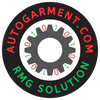Sequence Of A Garments Inspection. Clock Wise Method
Garment Inspection
Garments Inspection first start from inside & left hand side after complete inside inspection then start topside inspection on the same way. Based on PEI quality requirements, each factory is required to have a location for the purpose of conducting finished product quality inspection. This location will be called a “Factory Quality Assurance Center” or FQAC. The objective is to implement this concept across all factories that have continuous orders with PEI as a mandatory rule. We sale Garments Quality Control Inspection Report Software .
This standard operating procedure will help our suppliers as well as PEI field QA associates understand the chronological order in implementing the set up of a FQAC and the process that follows thereafter including training and certification of factory auditor/s.
Inside of a Garments Left
- MAIN LBL, COLLAR, NK RIB, PLKT AREA .
- ARMHOLE, SLV JOINT.
- SLV CUFF, HEM.
- SIDE SEAM,.
- BOTTOM HEM

Inside of a Garments Right
- MAIN LBL, COLLAR, NK RIB, PLKT AREA .
- ARMHOLE, SLV JOINT.
- SLV CUFF, HEM.
- SIDE SEAM, CARE LBL (COL. CODE, SIZE).
- BOTTOM HEM.
Topside of a Garments Left
- MAIN LBL, COLLAR, NK RIB, PLKT AREA .
- ARMHOLE, SLV JOINT.
- SLV CUFF, HEM.
- SIDE SEAM, CARE LBL (COL. CODE, SIZE).
- BOTTOM HEM.
Topside of a Garments Right
- MAIN LBL, COLLAR, NK RIB, PLKT AREA
- ARMHOLE, SLV JOINT.
- SLV CUFF, HEM.
- SIDE SEAM, CARE LBL (COL. CODE, SIZE).
- BOTTOM HEM.
- SIDE FLAT.
- SELF CODE NO. USE
Conducting clock wise inspection method on bottoms-
- Inspect the wearer’s right back panel and ensure that it is free from fabric flaws, dirt/stains or holes and color variation between back panels and front panels
- Hold the garment upright and verify if the legs are twisting.
- Finally inspect the inside part of garment ensuring that it is clean and the seams are well secured while there are no uncut and loose thread. Turn inside out up to crotch level.
- Inspect the wearer’s left front panel including pleats for appearance and ensure that it is free from fabric flaws, dirt/stains, holes and for shade variation against waist band, right front panel as well as the wearer’s left back panel.
- Inspect the wearer’s left pocket and pocket bag construction details and verify if they are correct and look tidy.
- Inspect wearer’s left side seam construction details to verify it is correct and looks good. Pull seams gently apart.
- Inspect left bottom hem both front and back and inside to ensure that the construction is correct and looks good.
- Inspect the left inseam construction to ensure that the sewing details are correct and seams look good. Pull seams gently apart.
- Inspect the right inseam as above. Pull seams gently apart.
- Inspect right bottom hem both front and back and inside to ensure that the construction is correct and looks good.
- Inspect the wearer’s right side seam. Pull seams gently apart.
- Inspect the wearer’s right pocket and pocket bag construction details if they are correct and look tidy.
- Inspect the wearer’s right front panel for appearance including pleats so that it is free from fabric flaws, dirt/stains or holes
- Inspect the back rise construction detail to ensure that they are correct and seams look tidy. Pull seams gently apart
- Inspect the crotch seam, fly edge, bar-tack, and J stitch to ensure that all construction details are correct and looks good. Pull crotch seams gently apart.
- Slide zipper up and down two to three times to ensure that the zipper puller is sliding smoothly. If there are buttons instead of zipper, unbutton and button to ensure that button can slide through button hole easily and that buttons (if two or four hole) are attached with lock stitch where thread end is not raveling.
- Unbutton and button the waist button to verify that it goes through the button hole comfortably and the placement of the button or hook and bar is correct. Verify that the center front edge is straight at front rise from waist band to fly edge. If using a two or four-hole button, ensure button is securely attached with lock stitch and thread end does not ravel. Since waist button is a stress point, ensure button is whipped for security between button and waist (shank).
- Inspect the waist construction in and out ensuring that the sewing details are correct and neat. Ensure that the waist seams do not have uneven ease. Pull waist seams gently apart.
- Check all belt loop placement and size if they are correct to specification. Ensure belt loop inside and outside finish does not show any raw edges.
- Inspect the wearer’s left back panel and ensure that it is free from fabric flaws, dirt/stains or holes and for shade variation against wearer’s right back panels.
- Inspect the wearer’s left back pocket and yoke and ensure the construction details and appearance looks good. If there are buttons, follow as per previous steps regarding button and button hole.
Conclusion
Similarly Garments Inspection the wearer’s right back pocket and yoke and ensure the construction details and appearance looks good.


